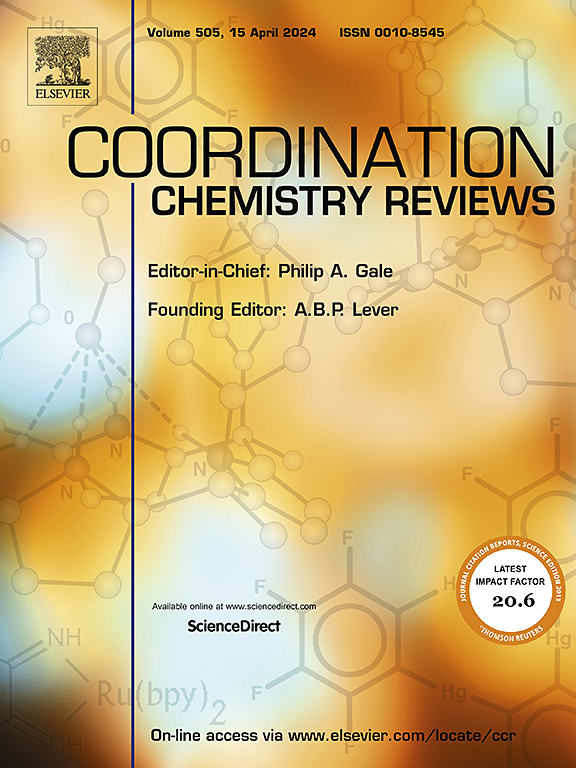近红外成像和治疗小分子探针研究进展
IF 23.5
1区 化学
Q1 CHEMISTRY, INORGANIC & NUCLEAR
引用次数: 0
摘要
在医学成像和癌症治疗领域,利用荧光(FL)方法监测和识别疾病是一种常用的检测方法。这些检测工具的功能是通过检测癌症相关的生物标志物来增强荧光信号的响应,从而有针对性地显示病变的位置。其中,小分子活化探针(small molecule activatable probe, SMAPs)可以通过设计生物标志物的分子结构来实现对不同生物标志物的识别功能。特别是对于近红外(NIR)区域的SMAPs (900-1880 nm),与可见光(400-700 nm) SMAPs相比,近红外光波长更长,在生物组织中的散射和吸收更低,穿透深度明显优于可见光,自动fl弱,成像信噪比高,适合于深层组织观察和高灵敏度检测。经过修饰后,NIR SMAPs可以更快地响应与体内生理参数相关的各种肿瘤和炎症的变化。它们可以准确地发现癌症转移,使有针对性和更好的治疗选择,并改善癌症预后。因此,本文根据不同生物标志物的类型、在肿瘤成像和治疗中的应用以及新兴的多模式引导成像和肿瘤治疗方案,介绍了NIR-I (700-900 nm)/NIR-II (900-1880 nm)区域SMAPs的触发机制。最后,讨论了近红外SMAPs在生物医学领域进一步发展的前景和面临的困境。本文章由计算机程序翻译,如有差异,请以英文原文为准。
Recent advances in NIR small molecule activable probes for imaging and therapy
In the field of medical imaging and cancer treatment, the use of fluorescence (FL) methods to monitor and identify diseases is a common detection method. The function of these detection tools is to enhance the response of fluorescent signals by detecting cancer-related biomarkers to display the location of lesions in a targeted manner.
Among them, small molecule activatable probes (SMAPs) can realize the recognition function of different biomarkers by designing their molecular structures. Especially for SMAPs in the near infrared (NIR) region (900-1880 nm), compared with visible light (400–700 nm) SMAPs, NIR light has a longer wavelength, lower scattering and absorption in biological tissues, significantly better penetration depth than visible light, weak autoFL, and high imaging signal-to-noise ratio, making it suitable for deep tissue observation and high-sensitivity detection. After modification, NIR SMAPs can respond more quickly to changes in various tumors and inflammations, which are related to physiological parameters in vivo. They can accurately detect cancer metastasis and enable targeted and better treatment options, as well as improve cancer prognosis. Therefore, in this paper, we introduced the triggering mechanisms of SMAPs in the NIR-I (700–900 nm)/NIR-II (900–1880 nm) regions according to the types of different biomarkers, their applications in cancer imaging and treatment, and the emerging multimodal-guided imaging and tumor treatment regimens. Finally, the prospects and dilemmas of NIR SMAPs as further developments in the biomedical field are discussed.
求助全文
通过发布文献求助,成功后即可免费获取论文全文。
去求助
来源期刊

Coordination Chemistry Reviews
化学-无机化学与核化学
CiteScore
34.30
自引率
5.30%
发文量
457
审稿时长
54 days
期刊介绍:
Coordination Chemistry Reviews offers rapid publication of review articles on current and significant topics in coordination chemistry, encompassing organometallic, supramolecular, theoretical, and bioinorganic chemistry. It also covers catalysis, materials chemistry, and metal-organic frameworks from a coordination chemistry perspective. Reviews summarize recent developments or discuss specific techniques, welcoming contributions from both established and emerging researchers.
The journal releases special issues on timely subjects, including those featuring contributions from specific regions or conferences. Occasional full-length book articles are also featured. Additionally, special volumes cover annual reviews of main group chemistry, transition metal group chemistry, and organometallic chemistry. These comprehensive reviews are vital resources for those engaged in coordination chemistry, further establishing Coordination Chemistry Reviews as a hub for insightful surveys in inorganic and physical inorganic chemistry.
 求助内容:
求助内容: 应助结果提醒方式:
应助结果提醒方式:


